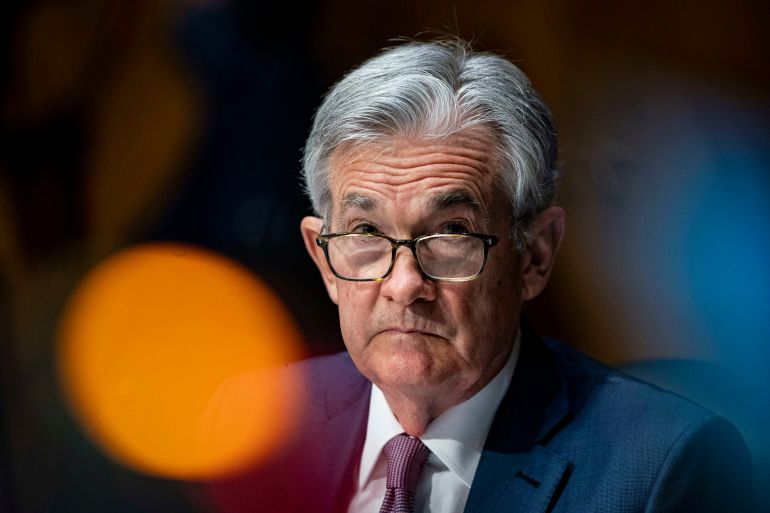Fed leaves interest rates unchanged, says US economy is improving
US Fed policymakers gently telegraphed that they are prepared to consider withdrawing some monetary support should economic conditions warrant it.

Policymakers at the United States Federal Reserve voted unanimously to leave interest rates unchanged at the end of their two-day meeting on Wednesday. The Fed will also continue to support the nation’s economic recovery by buying bonds at a clip of $120bn per month.
The monetary policy status quo came as no surprise, given that the Fed has long signalled it will keep its benchmark rate near zero until the US labour market is fully healed from last year’s COVID-19 blow. But Federal Reserve Chairman Jerome Powell said during his post-meeting virtual press conference that the US central bank would be prepared to reconsider current monetary policy should inflationary risks to the economic recovery emerge.
Keep reading
list of 4 itemsRussia’s Putin eyes greater support from China for Ukraine war effort
India-Iran port deal: A gateway to Central Asia or a geostrategic headache?
India’s income inequality widens, should wealth be redistributed?
The Fed noted that strong policy support along with progress on coronavirus vaccinations is propelling improvements in the nation’s economy and jobs market. But Powell said that the current unemployment rate of 5.9 percent understates the true scale of joblessness because the number of Americans either working or actively looking for work remains low.
In May, the US had a record 9.2 million openings, leaving businesses scrambling to fill positions. But in June, some 9.5 million people were counted as unemployed by the US Department of Labor.
That mismatch has generated controversy, with some blaming generous federal unemployment benefits for disincentivising the jobless to return to work. Others point to a lack of caregiving options during the pandemic for keeping jobless workers on the sidelines, as well as fears of contracting COVID-19.
Powell expressed confidence that these issues won’t last. “These factors should wane in coming months, leading to strong gains in employment,” he said.
The Fed has a dual mandate to achieve maximum employment and price stability. The big question, therefore, is when officials will become concerned enough about rising inflation to start dialing back easy-money policies.
Powell has said repeatedly that the Fed is willing to accept inflation running above its 2 percent target rate for some time if that is what it takes to get the jobs market back to its pre-pandemic strength.
Inflation is currently running well above the Fed’s longer-term target rate.
The Producer Price Index (PPI), which measures prices that businesses fetch for the goods and services they sell, rose 7.3 percent in June over the same period a year ago. That was the steepest advance since annual numbers were first crunched back in November 2010. Consumer prices, meanwhile, rose 5.4 percent in June – the largest annual increase since August 2008.
A little bit of inflation is a good thing for an economy because it incentivises consumers to buy goods and services now, rather than be tight-fisted in expectation of prices dropping. But too much inflation is decidedly bad, especially if it triggers a vicious upward price spiral that prompts monetary policymakers to hike interest rates suddenly and potentially derail economic recovery.
Fed policymakers are of the view that the uptick in inflation is a consequence of supply bottlenecks forming as businesses reopen all at once, and will likely prove temporary.
There were no hawkish statements from the Fed that it’s getting ready to take the training wheels off of the economic recovery any time soon. But Powell gently telegraphed that policymakers are prepared to consider withdrawing some monetary support should conditions warrant it.
“If we saw signs that the path of inflation or longer-term inflation expectations were moving materially and persistently beyond levels consistent with our goal, we’d be prepared to adjust the stance of policy,” he said.
When asked specifically if he is worried about higher wages fuelling inflation, Powell noted that most of the uptick in wages is happening in relatively low-paid jobs in the services industry. He also said there is no evidence of a wage-price spiral forming, in which unit labour costs go up and force companies to accept lower profit margins or raise prices.
“We don’t see that now,” said Powell. “This is something that was a feature of the high inflationary era of great inflation, but it’s not a feature now.”
During his press conference, Powell noted risks to the economic outlook, including slowing coronavirus vaccination rates and the Delta strain of COVID-19 spreading in some areas of the country.
“Continued progress on vaccinations would support a return to more normal economic conditions,” he said.